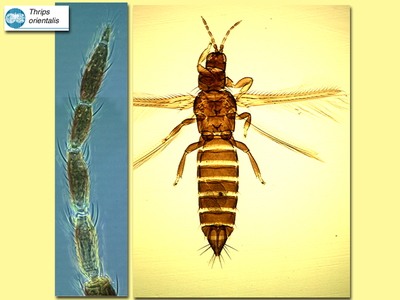Figures
Fig. 1 Antenna and head (dorsal)
Fig. 2 Head and pronotum
Fig. 3 Fore and hind wing
Fig. 4 Meso- and metanotum
Fig. 5 Sternite II-IV
Fig. 6 Sternite VI-VII
Fig. 7 Tergite VIII (female)
Species
Thrips orientalis Bagnall
Biology
A south east Asian species usually recorded from Gardenia or Jasminum flowers.
Distribution
Found from Malaya to New Caledonia, but not yet recorded from Australia; also introduced to Caribbean region.
Recognition
Body and legs brown, tarsi paler, antennal segments III-V with yellow markings near base; forewing uniformly brown. Head with 2 pairs of ocellar setae, pair III shorter than one side of ocellar triangle and arising on the margin of the triangle. Antenna 7-segmented, III & IV with sense cone forked, III-VI unusually slender. Pronotum with transverse lines of sculpture, 2 pairs of long posteroangular setae. Metanotum with many small equiangular reticulations, each with internal markings; median setae long and distant from anterior margin. Forewing with setal row on first vein variable, either complete or with a short gap before the 8 or more distal setae; second vein with complete row; clavus with sub-apical seta longer than apical seta. Tergites IV-VIII with paired ctenidia laterally, on VIII posteromedially to spiracle; VIII with posteromarginal comb present laterally but not medially. Sternites III-VI with 1-3 pairs of discal setae laterally, II & VII with no discal setae. Male similar to female, abdomen more slender, tergite IX median setae longer than sub-median setae; sternites III-VII with glandular area wide and slender but no discal setae.
Related species
This species is related to T. parvispinus and T. taiwanus in having discal setae on the median sternites but lacking them on sternite VII. The metanotal sculpture is reminiscent of that of T. simplex but with the reticles more equiangular.








